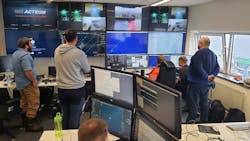Remote survey services reducing project carbon footprint, mobilizations and costs
Editor's note: This story first appeared in the May-June 2023 issue of Offshore magazine as part of the Remote Inspections & Operations Special Report.
By Torsten Marten, UTEC
In the energy sector, the acquisition and processing of data associated with operations has traditionally involved the mobilization of personnel and equipment to offshore locations around the globe. However, with the need to minimize carbon footprint and costs, which are particularly important considerations for clean energy stakeholders, operators are looking for innovative ways to develop and operate assets across the renewable energy, oil and gas, and nearshore construction industries.
Acteon, a marine energy and infrastructure services company, reviews the impact of a remote technology that can be deployed to reduce survey costs and increase project efficiency. Within a project life cycle, the overall operational schedule can be improved by optimizing the individual survey tasks and conducting some of those activities remotely. From site characterization through to decommissioning, accurate survey data enable the operator to plan, mitigate potential challenges and choose the optimal design solution.
One piece of technology used by Acteon to enhance overall project efficiency is the communications hub (comms hub) developed by UTEC, a geo-services brand in Acteon’s Data and Robotics division. It provides the communications security and network resilience required to deliver all types of remote services using any available internet connection. While bringing data ashore in real time, the comms hub checks the characteristics of each bonded link for error rate, packet loss, jitter and latency to determine which way a particular packet should be dispatched. By adapting rapidly to network conditions found offshore, where the characteristics of satellite links change frequently, the comms hub enables network acceleration, bringing data ashore securely and efficiently.
The comms hub can provide live H.265 video streams from a remotely operated vehicle (ROV) or any camera on board a vessel, to multiple onshore and offshore locations without the need to mobilize any additional equipment or personnel. The comms hub facilitates remote operation of online navigation software and remote technical support by providing direct remote access to the offshore survey network. Additionally, it enables remote data processing via automated file transfer in close to real time.
As the remote technology can reduce personnel on board by up to 30% by bringing tasks onshore, it reduces aviation and other travel costs while retaining access to highly skilled personnel when required. The carbon footprint of operations can be reduced and improved safety is realized from a reduced offshore headcount. Because data-processing personnel are only paid for the time they work on the data, and not their mobilization and standby time, cost savings are generated that can be passed on to clients.
Case study
Havfram, which provides installation and early phase development of offshore wind farms, was contracted by an energy operator to perform a decommissioning project in Mauritania that involved the removal and disposal of subsea infrastructure. The survey services included post-decommissioning multibeam echo sounder (MBES) surveys carried out by an ROV.
A UTEC comms hub installed on the Havfram vessel Island Victory provided automated file transfer functionality, facilitating remote data processing. This was required non-stop during the surveys, which involved six umbilicals, nine jumpers and nine mooring lines. On this project, only one data processor was on board, and one remote processor worked onshore. Without requiring additional bandwidth, the comms hub automatically transferred the MBES data with backscatter intensity measurement enabled. The remote data processor worked from the UK, thereby reducing risk exposure, saving time, minimizing cost and reducing carbon footprint.
Conclusion
By facilitating remote services, Acteon is bringing ashore many of the tasks traditionally conducted offshore, achieving significant project time and cost savings. Simultaneously, risk exposure and carbon emissions associated with offshore mobilizations are reduced.
Acteon is continuing to invest in remote capabilities to support operators, particularly in the offshore wind sector. Its focus is on subsea operations, maintenance, inspection and survey work for critical infrastructure such as inter-array cables, export cables, monopile visual inspection and scour surveys.
